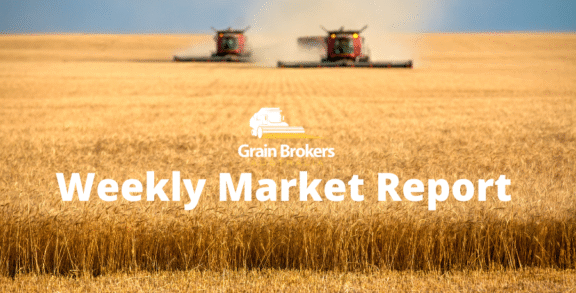
Grain imports the key to satisfying east coast demand
Grain Brokers Australia > Weekly Wire
by Peter McMeekin
The United States Department of Agriculture (USDA) released their August World Agricultural Supply and Demand (WADSE) report late last week. The key futures indices certainly reflected the bearish report tone in last Friday’s trading session and that trend continued into the first trading session this week.
Nevertheless, there were plenty of surprises. The market certainly expected the corn and soybean yields to increase, but not by as much as they did, coming in at 178.4 bushels per acre (bu/ac) and 51.6 bu/ac respectively. If these yields come to fruition it will see the United States (US) harvest their third largest corn crop and their largest ever soybean crop. Great for global supply but not so great for the US farmer while Trump continues to raise the rhetoric and play the tit-for-tat trade tariff game with China.
As expected, the USDA has forecast a further decline in world wheat production for the 2018/19 season. On the back of five consecutive years of record global production, the USDA has pegged this season’s global wheat crop at 729.6 million metric tonnes (MMT). This is down almost 4 per cent from the 2017/18 record of 758MMT.
The surprise here was they only cut production by 6.7MMT. The EU number came in well above trade expectations at 137.5 MMT, down 7.5MMT from July and more than14MMT lower year on year. Like Australia, many parts of Europe have been unseasonably dry and hot with substantial production decreases reported in Germany, Bulgaria, Romania and Sweden, just to name a few.
Canada was left unchanged, at 32.5MMT, when the market expected a production cut. Ukraine was also unchanged at 25.5MMT, despite recent local estimates suggesting the crop was as low as 24.4MMT. The Russian crop was increased to 68MMT, down from 84.9MMT last year, but up to 2MMT above some of the most recent internal Russian estimates.
From an Australian point of view, the biggest surprise in the WADSE report was leaving production here at home unchanged at 22MMT. That puts this year’s Australian wheat crop higher than last year’s, with vast swathes of Queensland and New South Wales stuffed (technical term) and many parts of Victoria and South Australia experiencing less than ideal growing conditions.
Thank goodness that the Western Australian conditions are the complete antithesis to the eastern states, with recent production forecasts suggesting the wheat harvest there could exceed 10MMT. Total grain production in the state is forecast at around 15.5MMT and growing on the back of extremely timely in-crop rains and warmer than normal temperatures through the winter.
All that said, it is hard to see this season’s domestic wheat crop exceeding 18MMT. There is upside with a good spring but minimal on the east coast. A poor spring and it could easily be much lower.
So where does that place us from a domestic wheat demand viewpoint? The number is fine. More than enough to meet Australia’s food, feed and seed demand of around 10MMT. However, the proximity of the majority of the production to the primary demand points creates the challenge.
We are already seeing the evidence. By the end of August, seaborne imports of wheat and barley into the port of Brisbane from other states of Australia will exceed 400,000MT since October last year. The Brisbane and Darling Downs domestic feed markets are driving both wheat and barley prices across the entire country.
All the wheat and barley production in Queensland and New South Wales will be required domestically. With the crop deteriorating in those states every day, the exportable surplus in Victoria is shrinking quickly as it is the easiest grain to move into the demand points further north.
But even that will not be enough. The coastal vessels will be kept busy well into 2019 moving grain from South Australia and Western Australia to keep up with burgeoning east coast demand. Basically, the domestic grain consumers in Queensland and New South Wales must buy wheat (and barley) away from the export pathways to ensure that this domestic demand is met.
It is the function of grain prices right across this drought-scorched land to allocate the limited winter crop grain production in the most efficient manner possible. Substantial rain is required for a summer crop plant in Queensland and northern New South Wales so it may not be until the 2019 winter crop harvest that real production relief arrives and we see a relaxation of the localized domestic shortfalls.






